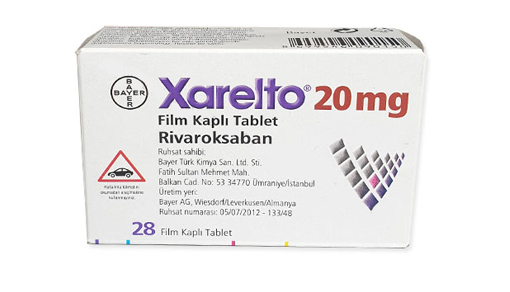Rivaroxaban Medication Guidance: A Comprehensive Guide for Patients

Rivaroxaban Medication Guidance: A Comprehensive Guide for Patients
Venous thromboembolism (VTE), a prevalent health concern, can give rise to serious complications such as deep vein thrombosis (DVT) and pulmonary embolism (PE). To address these conditions, healthcare providers often recommend Rivaroxaban, an effective oral anticoagulant. This guide aims to offer in - depth insights into Rivaroxaban, including its usage, benefits, and potential risks, empowering patients to manage their treatment more effectively.
1. Indications and Mechanism of Action
Rivaroxaban, a direct factor Xa inhibitor, works by blocking the activity of factor Xa, an essential component in the blood - clotting cascade. By inhibiting factor Xa, Rivaroxaban prevents the conversion of prothrombin to thrombin, thereby reducing the formation of blood clots.
This medication is primarily prescribed for:
Prevention of Venous Thromboembolism: It is commonly used to prevent VTE after major orthopedic surgeries, like total hip or knee replacement. Additionally, it can be prescribed for long - term VTE prevention in patients who are immobile for extended periods.
Treatment of Deep Vein Thrombosis and Pulmonary Embolism: Rivaroxaban serves as a viable option for both the initial treatment and long - term management of DVT and PE, helping to dissolve existing clots and prevent new ones from forming.
2. Dosage and Administration
The appropriate dosage of Rivaroxaban depends on the individual patient's condition and medical history. Here are the general dosage guidelines:
Prevention of Venous Thromboembolism: For most patients, a daily dose of 10 mg taken orally is recommended. When used for post - surgical prevention, it is typically initiated 6 - 10 hours after surgery and continued for at least 10 days.
Treatment of Deep Vein Thrombosis and Pulmonary Embolism: The initial treatment involves taking 15 mg twice a day for the first 21 days, followed by a maintenance dose of 20 mg once a day.
It's important to note that factors such as age, weight, and liver function may influence the dosage. Always follow your doctor's or pharmacist's instructions regarding the specific dosage that's right for you.
3. Precautions and Side Effects
When using Rivaroxaban, several precautions should be taken:
Adhere to Medical Advice: Strictly follow your healthcare provider's instructions regarding the dosage and duration of treatment. Do not change the dosage or stop taking the medication without consulting your doctor first.
Monitor for Bleeding: Rivaroxaban increases the risk of bleeding. Before starting the treatment, your doctor will assess your bleeding risk. If you experience unusual bleeding, such as excessive nosebleeds, blood in urine or stool, or prolonged bleeding from minor cuts, contact your doctor immediately.
Be Aware of Drug Interactions: Some medications, including other anticoagulants, antiplatelet drugs, and non - steroidal anti - inflammatory drugs (NSAIDs), may interact with Rivaroxaban and increase the risk of bleeding. Inform your doctor about all the medications you are taking, including over - the - counter drugs and herbal supplements.
Common side effects of Rivaroxaban may include gastrointestinal discomfort (such as nausea, vomiting, or abdominal pain), skin rashes, and itching. Although severe bleeding is rare, it can occur. If you experience any side effects or concerns during treatment, reach out to your healthcare provider promptly.
4. Monitoring During Treatment
Regular monitoring is crucial while taking Rivaroxaban:
Blood Tests: Your doctor may order blood tests, including platelet counts and coagulation profile, before and during treatment to assess the effectiveness of the medication and ensure your safety.
Symptom Observation: Pay close attention to any signs of abnormal bleeding or bruising. Report any unusual symptoms to your doctor immediately.
Follow - up Appointments: Attend all scheduled follow - up appointments as recommended by your doctor. These appointments allow your doctor to monitor your progress, adjust the treatment plan if necessary, and address any concerns you may have.
Cost Considerations
The cost of Rivaroxaban can vary depending on several factors, such as the pharmacy you choose, your insurance coverage, and the region where you live. For some patients, the cost of this medication may pose a financial burden, especially if they do not have adequate insurance coverage. It is advisable to discuss the cost with your doctor or pharmacist. They may be able to suggest cost - saving options, such as using generic alternatives if available, applying for patient assistance programs, or exploring different pharmacies with more favorable pricing. If you have any questions or need further assistance regarding the cost of Rivaroxaban, you can consult the customer service at reliable medical information platforms, such as the Dingxiang customer service.
Case Studies
Case 1: Post - Surgical Prevention
Question: I just had a total knee replacement surgery, and my doctor prescribed Rivaroxaban. How long do I need to take it, and what should I watch out for?
Answer: For post - surgical prevention of VTE after a total knee replacement, you will typically take 10 mg of Rivaroxaban orally once a day. The treatment usually starts 6 - 10 hours after surgery and continues for at least 10 days. During this period, closely monitor for any signs of bleeding, like excessive bruising, nosebleeds that don't stop easily, or blood in your urine or stool. Also, inform your doctor if you experience any unusual pain or swelling in your legs.
Case 2: Treatment of Deep Vein Thrombosis
Question: I was diagnosed with deep vein thrombosis, and my doctor said I need to take Rivaroxaban. What's the correct dosage, and how long will I be on this medication?
Answer: For the treatment of DVT, you will start with 15 mg of Rivaroxaban taken twice a day for the first 21 days. After that, the dosage will be adjusted to 20 mg once a day for maintenance. The total duration of treatment depends on various factors, such as the severity of your DVT and your overall health. Your doctor will determine the appropriate length of treatment. Remember to have regular follow - up appointments and blood tests as your doctor advises to ensure the treatment is working effectively and safely.
In conclusion, Rivaroxaban is a valuable medication for preventing and treating venous thromboembolic disorders. By understanding its indications, dosage, precautions, and potential side effects, and by closely following your doctor's instructions, you can manage your condition more effectively and reduce the risk of complications. If you have any questions or concerns about Rivaroxaban, don't hesitate to consult your healthcare provider or relevant customer service for further support.

